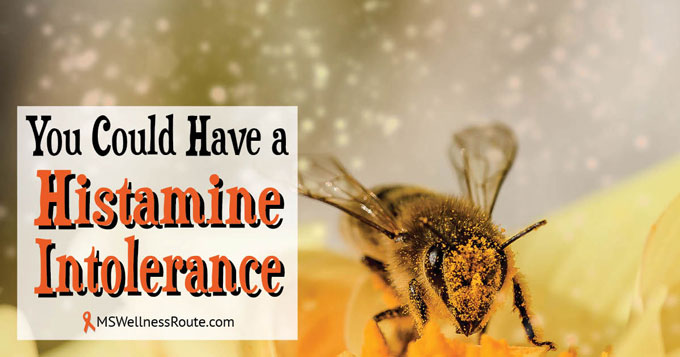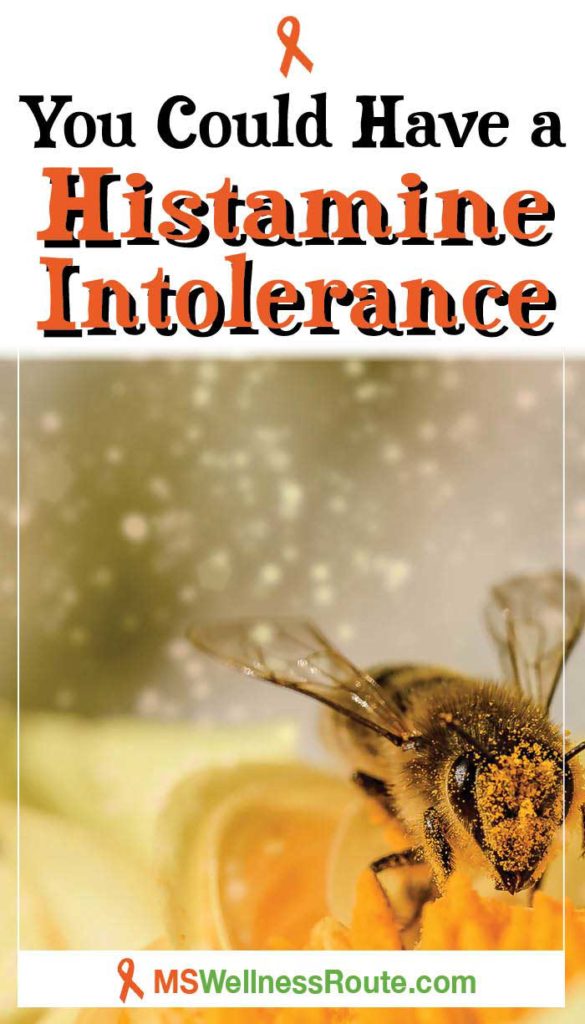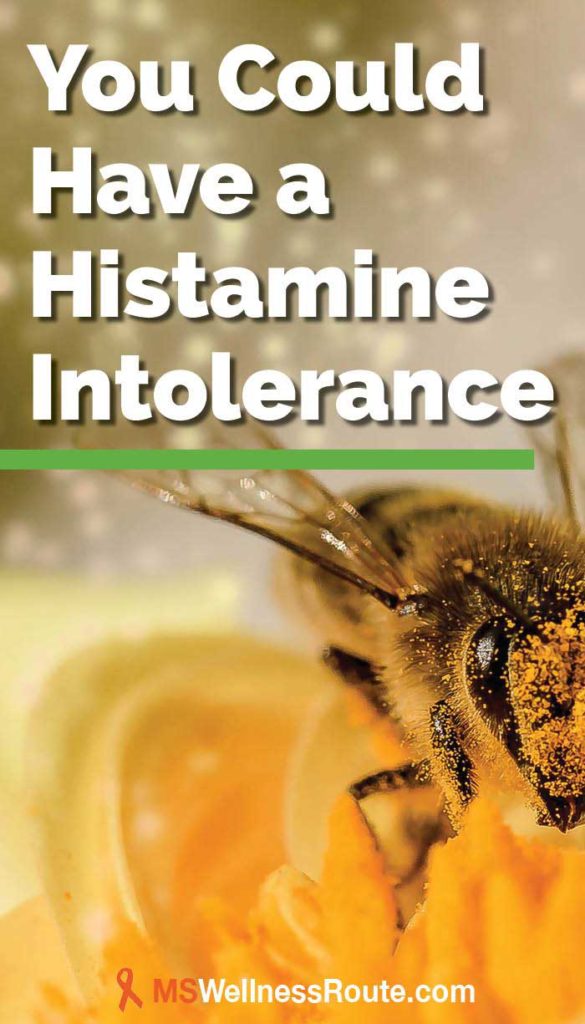Last Updated on December 4, 2023 by Cathy

Histamines are chemicals your body makes to quickly remove allergens from your body or off of your skin. Like when you breathe pepper and it makes you sneeze or how onions make you tear up. It’s part of your body’s defense mechanism.
Histamine intolerance is a condition where the body has difficulty breaking down histamine, a compound found in certain foods, leading to symptoms like headaches and hives. Individuals with histamine intolerance often need to follow a low-histamine diet to manage their symptoms effectively.
According to Wikipedia –
“Histamine is an organic nitrogenous compound involved in local immune responses, as well as regulating physiological function in the gut and acting as a neurotransmitter for the brain, spinal cord, and uterus. Histamine is involved in the inflammatory response and has a central role as a mediator of itching.”
Fortunately, histamine protects us from bacteria, viruses, and other inflammations. When our immune system reacts to something foreign entering our body, such as dust. Histamine sees this as a threat and kicks into action to push it out.
Allergens are mostly harmless like animal dander, dust, and food. But when the immune system mistakes these as harmful it kicks up the histamine reaction. Which then creates allergy-like symptoms.
Every spring my son has severe seasonal allergies. As the pollen levels rise his immune system goes into action by releasing histamines. He sneezes, coughs, has a runny nose, and his eyes water. He’s miserable for about a month until the pollen calms down.
When you have a histamine reaction to a certain substance your immune system mistakes it as harmful to your body. It then alerts some cells to release histamine into the bloodstream. The histamine acts on the eyes, lungs, nose, skin, and throat. It even acts on the gastrointestinal tract.
There is a food diary at the bottom of this post to help you keep track of any food reactions.
Antihistamines and Multiple Sclerosis (MS)
Researchers discovered the antihistamine clemastine improved the optic nerve in people with MS. The myelin which protects the nerves was repaired improving nerve pathways. Clemastine is an over-the-counter allergy medication. You can find it in common brand names such as Allergy Relief.
What causes high histamine levels?
If you have food sensitivities, your body releases histamines for that too. Some foods are higher in histamines than others. Especially in fermented foods like kombucha. I used to always drink kombucha for the good bacteria, I even started making my own to save money. But then I stopped, I don’t remember why. When I drank more kombucha a few months later I realized it was making me burp. My body was creating histamines to the kombucha.
Causes of high histamine levels:
- Allergies
- Candida overgrowth
- Diamine oxidase deficiency
- Foods high in histamines
- Irritable bowel syndrome (IBS)
- Leaky gut
- Small intestinal bacterial overgrowth (SIBO)
- Vitamin and mineral deficiency, usually from a lack of vitamin C, B6, or magnesium
Diamine Oxidase (DAO)
People have an enzyme called diamine oxidase (DAO). It breaks down histamine which is then expelled through our kidneys or urine. If you have enough DAO the histamine is broken down and does not cause any issues.
Unfortunately, some people have a low level of this enzyme. Which causes higher levels of histamine in their system causing histamine sensitivity. If you suspect you have too much histamine or you do not have enough DAO enzyme there are things you can do.
Symptoms of high histamine levels:
- Brain fog
- Burping
- Bloating
- Chest pain
- Constipation
- Depression
- Dizziness
- Fatigue
- Flushing
- Headaches
- Heartburn
- Indigestion
- Irregular heartbeat (palpitation)
- Insomnia
- Joint pain
- Muscle pain
- Nasal congestion and sneezing
- Restless leg syndrome (RLS)
- Ringing in the ears (tinnitus)
There are also certain foods that block the DAO enzyme which causes histamine levels to rise.
Foods that block DAO:
- Alcohol
- Energy drinks
- Black tea
- Green tea
Quick Links to Information in This Post:
Diet
Most foods contain histamine, so you can’t go on a “histamine-free” diet like you can with gluten. You can though, reduce the number of histamines you are ingesting. Any food that requires fermentation will result in high levels of histamine.
Foods high in histamine:
- Aged foods (buttermilk, sour cream, yogurt, etc.)
- Alcohol
- Cheese, all types
- Fermented vegetables (carrots, pickles, sauerkraut)
- Misco
- Natto
- Vinegar
Other foods that include higher levels of histamine:
- Canned foods
- Chocolate and cocoa-based foods
- Fruits (apricot, banana, citrus fruit, dates, pineapple, plum, pumpkin, strawberry, and tomato)
- Leftover protein, bacteria quickly act on protein creating histamines (freeze leftovers)
- Nuts (cashews, walnuts, etc.)
- Processed meats
- Vegetables (avocado, eggplant, and spinach)
When a person ingests something their body is sensitive to it creates inflammation. Whether it is an allergy or sensitivity. If the person is allergic to the food it creates an immediate response. In a histamine reaction, it usually takes longer for symptoms to appear.
If you suspect a histamine intolerance, reduce as many foods that are high in histamine as possible. Hopefully, you will notice if there are any improvements. Keep a food diary to track symptoms and figure out which foods to avoid and which ones are okay to eat (you can find a food diary at the bottom of this post).
Boost Your DAO Levels
As you are trying to heal from MS it seems like your diet gets more and more restrictive. Even I feel this way at times. But there are still lots of foods that are low in histamine that you can enjoy.
Low-histamine foods:
- Coconut milk
- Coconut oil
- Freshly caught fish
- Freshly cooked meats
- Fruits (except apricot, banana, citrus fruit, dates, pineapple, plum, pumpkin, strawberry, and tomato)
- Olive oil
- Vegetables (except avocado, eggplant, and spinach)
There are some foods that include nutrients that are effective in boosting DAO enzyme levels. And are less likely to trigger a histamine response.
Foods to include:
- Calcium – broccoli, dark leafy greens (except spinach), sesame seeds
- Iron – broccoli, grass-fed meats, pumpkin seeds
- Magnesium – flaxseeds, pumpkin seeds, salmon
- Omega-3 – chia seeds, flaxseeds, mackerel, olive oil, salmon
- Vitamin B12 – grass-fed beef, liver, salmon, trout
Overcoming a histamine intolerance
Histamines aren’t bad for you, you need them to fight toxins and inflammation. They are only a problem when the levels are too high. To correct the histamine overload, your best option is to correct your gut’s health.
- Reduce foods high in histamine
- Boost the DAO enzyme
- Avoid DAO-blocking foods
Reduce the number of foods that are high in histamines. Or the foods that block the enzyme that breaks down histamines. You should begin to notice a difference. This is not a permanent solution. As you are healing you should be able to add many of these foods back into your diet.
There is a blood test you can get to check your histamine levels or DAO levels. If you’re interested in getting tested, talk to your doctor. You can also try an elimination diet by removing foods high in histamines. Then after a month reintroduce them one at a time to see if your body reacts.
It’s all connected… fixing your leaky gut and getting more good bacteria is your first line of defense.
Get Access to My Free Library!
Get the password for my library including the Food Diary here by filling out this form:
Want to remember this? Pin it to your favorite Pinterest board!


You Could Have a Histamine Intolerance





